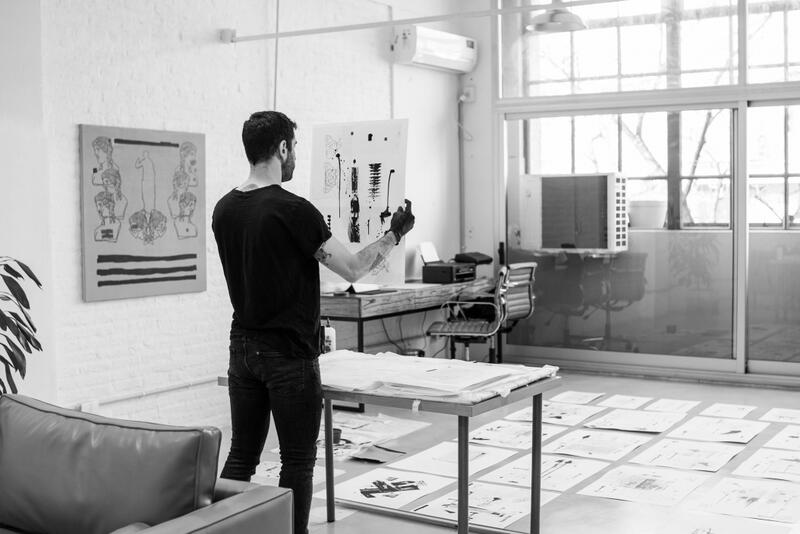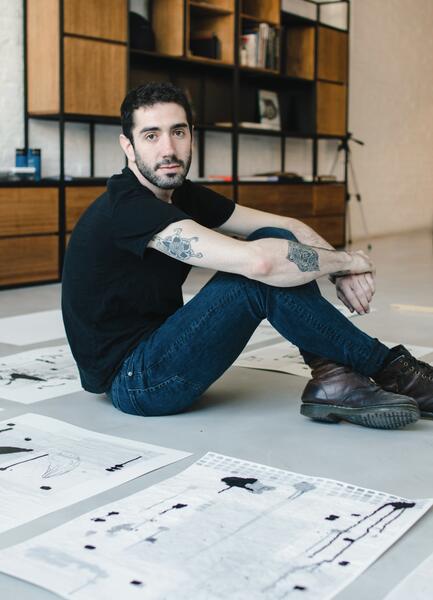JULIÁN BRANGOLD, A CONTEMPORARY ARTIST
After a stay of more than three years in Berlin, Julian Brangold (1986) is reinserting himself into the Argentine art scene through tattooing and a new drawing series that highlight the dependence of postmodern humans with technology. Film director at the Film University (FUC), the Argentine painter-far from assuming an apocalyptic stance- seeks to address the problems posed by the new techno-digital paradigm, on the one hand, and to question the speculative relationship that comes from commercialization of works of art, on the other.

With 31 years old, Brangold has been trained as a painter in artists workshops such as Guillermo Roux, Claudio Roncoli and Sergio Bazán. Although he defines cinema as one of the richest artistic media due to its multisensory and ability to empathize with the viewer, after completing its studies he decided not to himself into the film industry.
"Too many people dedicated to an extensive process for the realization of a single project. In my case, the cinema functioned as a means stripped of the traditional elements that make up the typical stories of commercial cinema. In short, cinema worked to me as a visual medium in the service of creation. During my last years at university I was more interested in filming and editing individually and at the moment. I started having a relationship of desire / creation with the environment ".
Also, Brangold argues that the relationship he began to have with the cinema was the result of a course given by Andrés Denegri, eminence of national video art.
"What interested me the most was editing: I always had that desperation to automatically create what I imagine. Now I learned to have more patience, the painting implies other rhythms and I ended up subordinating a bit to it times and materials ".
However, fate took him elsewhere. Two key events in a trip with a painter friend left him at the doorstep of this technique. "During those weeks in Europe there were two key events that made me rethink my situation as an artist and get fully into painting", explains Brangold sitting in his studio located at Colegiales (Buenos Aires, Argentina), and adds: "Then I understood how powerful painting was and how valuable is the relation between the painter and the work, very different from the cinema". Those two moments have a name and surname: Francis Bacon and Lucien Freud.
From there, Brangold began his training as a painter that led to a series of watercolors that inserted him into the contemporary art scene with the representation of Práxis Gallery – gallery with which he works today.
The watercolors consisted in the production of very small circles and colors on surfaces of one and a half meters by two meters. At the end of the process, all the circles came together through a line forming a kind of network. That aesthetic of his early work, probably influenced by his fascination with infographics and diagrams, appears as a constant throughout all Brangold's artistic work.
"I spent about three years producing and working with Práxis over the watercolors. But it became an obsessive work and I began to have a coiled relationship with the work and with the dynamics of the art world". Among other things, those were the reasons that took him to Berlin, where he ended up divorcing himself with art: he did not go to exhibitions, he did not paint, he did not visit museums. Until tattoo appeared.
In the German capital, Brangold came into contact with a collective of plastic artists - Noïa - who use the tattoo as a means of artistic expression and not as a service. Submerged into this new medium, Julián Brangold begun to develop an original workin comparison to the Argentine scene. Using the tattoo as an artistic platform, his illustrations establish a new relationship between those who decide to buy a piece of art and the piece itself. To paraphrase the artist, the tattoo eliminates the speculative character that predominates in most of the purchases of works of art. In contrast, the ink on the skin remains with the buyer forever.
Since his arrival to Buenos Aires, the response that Brangold received, both from those who consume and from those who produce art, has been positive and inevitably introduces a question to contemporary Argentine art in general.
"Unlike the outdoor fairs, in local fairs predominate paintings with the same techniques, colors and themes that ten years ago. It is logical, the Argentine market asks for it this way. But we have to start opening up new forms of expression"
Brangold's words are not only coherent, but also describe perfectly the stagnation of visual and plastic arts in relation to techniques, especially in countries that arent technologically developed, such as Argentina. In this way, the proposal of tattoos also fits the theme that crosses the most recent work of Brangold with painting and drawing: the relationship that individuals have with technology in the new universal context. By distorting the analog and digital processes in his paintings, Brangold seeks to establish a confusion where the viewer can not distinguish between digital printing errors and "mistakes" made on purpose. Thus, the work dialogues with the lack of understanding that people have about the exponential progress of technology over our ways of life and the dependency, dangers and social gaps that are behind this problem that advances faster than our assimilation capacity. Under these convictions, the artist proposes that: "The nation that manages to create artificial intelligence will first have supremacy over the others. The problem of undeveloped countries is that having less worker protections the unemployment that technological changes can generate are critical ".
In short, the figure of Julián Brangold and his inclusion in the Argentine contemporary art scene is something that should not be overlooked. On the one hand, with a highly postmodern view of the environment of the 21st century, the painter explores deep ground that perhaps only the cinema – in an extremely trite and apocalyptic way- and previously literature have managed to address until today, escaping, in addition, of the neighborhood and party apology that crosses most of the themes of Argentine art. On the other hand, his illustrations escape from the canvas and develop a new relationship with the viewer that challenges the hypocrisy of the art market.
-
 Ph: Johana Rambla.
Ph: Johana Rambla.




